
Agriculture is a major source of greenhouse gas (GHG) emissions globally. The growing global population is putting pressure on agricultural production systems that aim to secure food production while minimising GHG emissions. In this study, the GHG emissions associated with the production of major food commodities in India are calculated using the Cool Farm Tool. GHG emissions, based on farm management for major crops (including cereals like wheat and rice, pulses, potatoes, fruits and vegetables) and livestock-based products (milk, eggs, chicken and mutton meat), are quantified and compared. Livestock and rice production were found to be the main sources of GHG emissions in Indian agriculture with a country average of 5.65 kg CO2eq kg−1 rice, 45.54 kg CO2eq kg−1 mutton meat and 2.4 kg CO2eq kg−1 milk. Production of cereals (except rice), fruits and vegetables in India emits comparatively less GHGs with <1 kg CO2eq kg−1 product. These findings suggest that a shift towards dietary patterns with greater consumption of animal source foods could greatly increase GHG emissions from Indian agriculture. A range of mitigation options are available that could reduce emissions from current levels and may be compatible with increased future food production and consumption demands in India.








